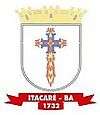Itacaré
Itacaré is a municipality in the cocoa zone of the state of Bahia in Brazil, south of Salvador.
Itacaré | |
|---|---|
Municipality | |
 The sun sets over Itacaré on Feb. 9, 2006 | |
 Seal | |
 Location in Bahia | |
| Country | |
| Region | Nordeste |
| State | Bahia |
| Time zone | UTC -3 |
Location
Itacaré is located 70 km north of Ilhéus where the Rio de Contas, which comes from the Chapada Diamantina, meets the Atlantic Ocean. Itacaré has about 27,000 residents. Out of these, approximately 50% live in the rural interior. A mixture of races - Amerindian, black and white - can be seen in the features of the natives, called "nação grapiúna", whom Jorge Amado affectionately referred to as "the captivating people of this land". The town was founded as a Portuguese colonial settlement, originally called São Jorge dos Ilhéus, in 1532. The town was a notorious hangout for Dutch and Portuguese pirates during the early colonial period and later became a hub for the cocoa planting and a port for whalers. It was officially given city status in 1881.
The municipality contains 41% of the 9,275 hectares (22,920 acres) Serra do Conduru State Park, created in 1997.[1] It also contains 14.88% of the 118,000 hectares (290,000 acres) Baía de Camamu Environmental Protection Area, created in 2002.[2]
Economy
After suffering a massive blight of Vassoura de Bruxa (Witch's broom) devastated the region's cocoa crops in the 1980s, Itacaré has depended mostly upon tourism. It is a popular destination for surfers, hikers and ecotourists. The town has a series of beautiful small cove-type beaches as well as Itacarezinho and other picturesque beaches further along the coast. Itacaré is on the edge of a national park, one of the last large expanses of Atlantic rain forest left in Brazil.
The change from sleepy agrarian town to tourist hotspot has not been an easy one, however. Locals recently won a hard-fought campaign to stop land owners who wanted to charge for access to the beaches.
Access to one of the most pristine beaches, Prainha, had been blocked by a hotel/condominium development called Sao Jose Eco Resort. Both Prainha and Sao Jose beaches are now accessible by foot, free of charge.
Despite development in the area, it remains a hub of Bahian culture. Many tourists visit Itacaré to take part in the local Capoeira circles and eat traditional Brazilian food. The town is flooded with revelers during New Year's and Carnival.
Itacaré has been mentioned as one of the world's top 10 best small towns
Travel Tips
Tourists must be cautious of volunteering opportunities which charge you to volunteer, once one knows how far $1 can go in Itacaré then things will be in true perspective. Research the prices of things in the local currency such as lodging and food etc. to get an idea, or talk to fellow travellers.
References
- Parque Estadual da Serra do Conduru: Ficha Técnica (in Portuguese), PESC: Parque Estadual da Serra do Conduru, retrieved 2016-10-26
- APA da Baía de Camamu (in Portuguese), ISA: Instituto Socioambiental, retrieved 2016-10-28
External links
| Wikivoyage has a travel guide for Itacaré. |
| Wikimedia Commons has media related to Itacaré. |